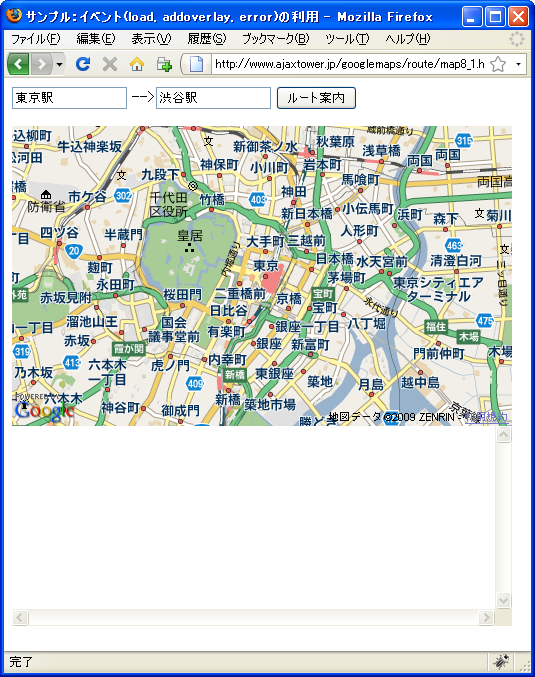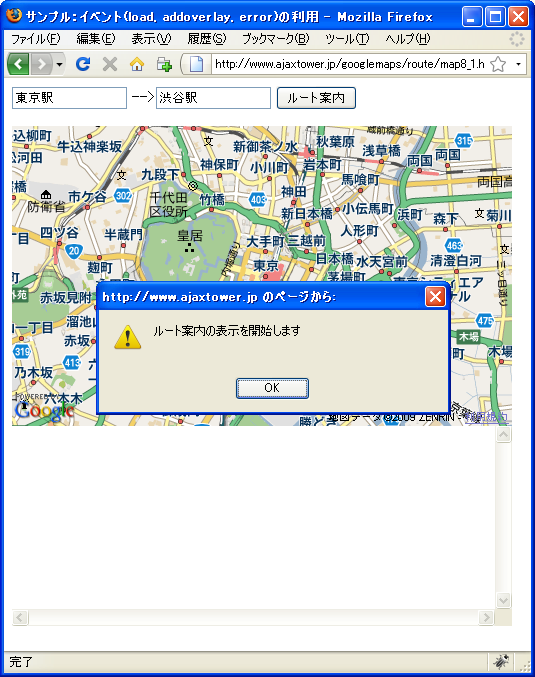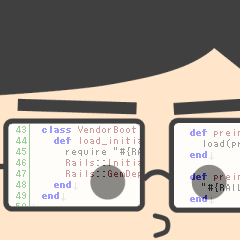- Home ›
- Google Maps API入門 ›
- ルート案内(GDirections) ›
- HERE
イベント(load, addoverlay, error)の利用
GDirectionsクラスのオブジェクトは3つのイベントを発行します。
load ルート結果が正常に返されたときに、オーバーレイ要素が地図やパネルに
追加される前にトリガされます。
addoverlay ポリラインまたはテキストのルート コンポーネント、あるいはその両方
が、地図または DIV 要素、あるいはその両方に追加された後にトリガさ
れます。
error ルート リクエストでエラーが発生した場合にトリガされます。
例えばルート案内の結果が返されてからルートの情報を個別に取得したい場合は、loadイベントを取得するように設定しておき、呼び出される関数の中で処理を記述します。
実際には次のように記述します。
var directions = new GDirections(map, document.getElementById("route"));
GEvent.addListener(directions, "load", onGDirectionsLoad);
GEvent.addListener(directions, "addoverlay", onGDirectionsAddOverlay);
GEvent.addListener(directions, "error", onGDirectionsError);
function onGDirectionsLoad(){
/* .. */
}
function onGDirectionsAddOverlay(){
/* .. */
}
function onGDirectionsError(){
/* .. */
}
なおエラーが発生した場合にはGDirectionsクラスのgetStatusメソッドを使ってエラー内容を取得できます。getStatusメソッドはオブジェクトを返します。オブジェクトには「code」プロパティと「request」プロパティが含まれます。
実際には次のように記述します。
var directions = new GDirections(map, document.getElementById("route"));
GEvent.addListener(directions, "error", onGDirectionsError);
function onGDirectionsError(){
var errCode = directions.getStatus().code;
alert(errCode);
}
サンプルプログラム
では簡単なサンプルで試してみます。
var map;
var directions;
function initialize() {
if (GBrowserIsCompatible()) {
map = new GMap2(document.getElementById("map_canvas"));
map.setCenter(new GLatLng(35.681379,139.765577), 13);
directions = new GDirections(map, document.getElementById("route"));
GEvent.addListener(directions, "load", onGDirectionsLoad);
GEvent.addListener(directions, "addoverlay", onGDirectionsAddOverlay);
GEvent.addListener(directions, "error", onGDirectionsError);
}
}
function dispRoute() {
var from = document.getElementById("from").value;
var to = document.getElementById("to").value;
directions.clear();
var pointArray = [from,to];
var option = {locale: "ja_JP"};
directions.loadFromWaypoints(pointArray, option);
}
function onGDirectionsLoad(){
alert("ルート案内の表示を開始します");
}
function onGDirectionsAddOverlay(){
alert("ルート案内の表示が終了しました");
}
function onGDirectionsError(){
var errCode = directions.getStatus().code;
document.getElementById('route').innerHTML = "エラーが発生しました:" + errCode;
}
<!DOCTYPE html "-//W3C//DTD XHTML 1.0 Strict//EN"
"http://www.w3.org/TR/xhtml1/DTD/xhtml1-strict.dtd">
<html xmlns="http://www.w3.org/1999/xhtml">
<head>
<meta http-equiv="content-type" content="text/html; charset=UTF-8"/>
<title>サンプル:イベント(load, addoverlay, error)の利用</title>
<script src="http://maps.google.com/maps?file=api&v=2&key=(key)&sensor=false"
type="text/javascript" charset="utf-8"></script>
<script src="./js/code8_1.js" type="text/javascript"></script>
</head>
<body onload="initialize()" onunload="GUnload()">
<form>
<input type="text" size="20" id="from" value="東京駅" />
--><input type="text" size="20" id="to" value="渋谷駅" />
<input type="button" id="btn1" value="ルート案内" onclick="dispRoute()" />
</form>
<div id="map_canvas" style="width: 500px; height: 300px"></div>
<div id="route" style="width: 500px; height: 200px;overflow: scroll"></div>
</body>
</html>
ではブラウザで上記のURLを見てみます。

「ルート案内」ボタンを押して下さい。正常にルートが取得できた場合は地図上やルート案内のテキスト表示が行われる前にloadイベントが発行します。

次に地図上の起点と終点にマーカーが設置され、ルート案内のテキスト表示が行われた後でaddoverlayイベントが発行しました。

地図上にルートがポリゴン表示されるのはこの後に行われました。
また終点に有効でない値を入力して「ルート案内」ボタンを押すとerrorイベントが発行します。

エラーコードはGGeoStatusCodeで定義されておりエラーコード602は「指定された住所の対応する地理的位置が見つかりませんでした。これは、住所が比較的新しいか、正しくないことが原因である可能性があります。」を表すエラーです。
( Written by Tatsuo Ikura )

 AjaxTower
AjaxTower